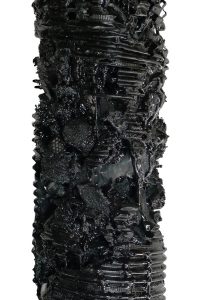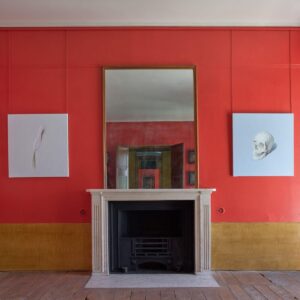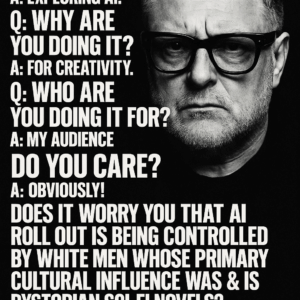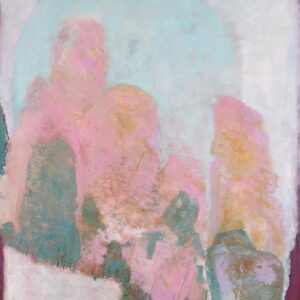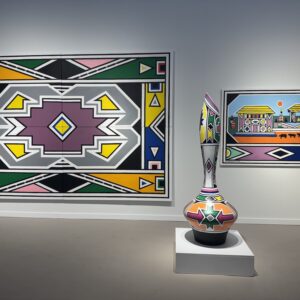
MAK Center for Art and Architecture presents What remains behind by Helmut Lang in the artist’s first solo institutional exhibition in Los Angeles at the Schindler House.
The historic house designed by fellow Austrian Rudolph Schindler provides the spare, proto-minimalist frame for a series of freestanding sculptures. As with all of Lang’s work, the visible and the invisible are put in direct play. Stating his preference for materials “with a past, elements with irreplaceable presence and with scars and memories of a former purpose,” Lang impregnates the architecturally hallowed space with the powerful but ghostly presences of collective pasts and unknown futures.
Every house tells a story. Some tell many. The famed Schindler House tells more than most. The architectural story of the first slab-cast modernist house, the progenitor of a mid-century experiment that situated Los Angeles on the intellectual and ideological coastlines of the great European and American traditions is well known. Less well known are the lifestyle experiments, contentions, dreams, allegiances and defections born within. This, the psychic architecture of the storied house, exists in the conversations around light, space, sex, the boundaries between inside and outside, between people seeking new means of manifestation that still cling to the patinated concrete slabs and fill the silent spaces in between. Within this real and imaginary framework, the work of another Austrian emigree lends its own version of what it is to be human to the concrete forms and enclosures that now house it.
Before being bound and hardened into fist-like forms whose presence now fills the empty rooms, Helmut Lang’s materials were soft, pliable, yielding and still bearing the scars of the past and the impress of memory upon them. His predilection for found or discarded material allows him, through the act of sculpting, to reshape narrative as much as form. Handed-down mattress foam, rubber and wax became the syntax of a language based on the malleability of material and memory. The results are works that both imagine the future and materialize the past. Literalizing repression, Lang calls upon the secret life of objects to reveal themselves through the prolapses of material whose meaning cannot be fully constrained. As a result, the tensions they hold are multiple. Neither entirely figurative nor entirely abstract, they bring a fundamentally reductivist approach to material that is deeply impregnated with the burden of history. Sometimes this reads as a confrontation between the body and its past derelictions. At others the current is sexual, an accumulated tension that itself becomes a stand-in for human identity, vulnerability and desire. Always they occupy a liminal space where form is in a continual state of becoming.
Within the Kings Road space, the presence of Lang’s sculptures transforms each of the storied rooms into echo-chambers reverberating ideas of materialized humanity across concrete, wood and glass. Proximity and aspect constantly change. Like emotions, they are fugitive, restless and refuse to settle into singular meanings and forms. Shape-shifting in character as much as form, depending on where one stands, they can appear mordant, lugubrious, tragic and even comic. But beneath these surface impressions is the undertow of darker sexualized forms of desire, a less palpable but more powerful energy field that forces us to confront the inherent tension between the body, the object, the gaze and the architecture that contains them. Just as all art is manifest thought, so these works are extroversions of interior conditions. Lang addresses the tensions between the public and private self. In doing so, he investigates the ways in which the invoked but absent body is both an object of desire and a site of personal expression.
Muscular and vulnerable, the contorted material is a registration of memory, a condition of post-traumatic distress that calls inevitably to ideas about the fragility of the human form and the malleability of identity. Time is compacted into the material. Disavowing the orderly rational illusion of time as steady and periodic, it pulses between the bodies of expression and reception as if to trace the unsettling arrhythmia of recurring traumatic experience. As with the architecture, what is within is without and what is without is within. — Neville Wakefield, Curator
Helmut Lang: What remains behind, Wednesday, February 19th — Sunday, May 4th, 2025
MAK Center for Art and Architecture
Curated by Neville Wakefield
About
Helmut Lang lives and works in New York City and on Long Island. He has exhibited since 1996 in Europe and the United States, among others, at the Florence Biennale, Florence (1996); Kunsthalle Wien, Vienna (1998); The Journal Gallery, New York (2007, 2019); kestnergesellschaft, Hanover (2008); The Fireplace Project, Long Island (2011); Schusev State Museum of Architecture, Moscow (2011); Mark Fletcher, New York (2012); DESTE Foundation for Contemporary Art, Athens (2013); Sperone Westwater, New York (2015, 2017); Dallas Contemporary, Dallas (2016); Sammlung Friedrichshof, Zurndorf (2017); Stadtraum, Vienna (2017); von ammon co, Washington DC (2019); MoCA Westport (2020); and Saint Laurent Rive Droite, Paris (2020) and Los Angeles (2021).
Neville Wakefield is a postmodern writer and curator interested in exploring the ways in which art behaves outside of institutional contexts. As senior curatorial advisor for PS1 MoMA and curator of Frieze Projects, he gained a reputation for challenging the conditions that shape art in both commercial and noncommercial contexts. Explorations of time and space have been a signature part of his practice. He has worked extensively with international institutions, including the Schaulager in Switzerland, where he curated the Matthew Barney retrospective Prayer Sheet with the Wound and the Nail one of the first shows to juxtapose the work of a contemporary artist with that of half a millennium before. Space as it relates to landscape and land art led him to co-found Elevation1049, a site-specific biennial in Gstaad, Switzerland, while also shaping the recurring Desert X exhibitions in the Coachella Valley region of Southern California of which he is Founding Artistic Director. He has also been instrumental in the development and success of Desert X AlUla, taking place in AlUla northwest Saudi Arabia, home to the country’s first UNESCO World Heritage Site, Hegra along with numerous other initiatives aimed at promoting art in the Gulf region.
The MAK Center for Art and Architecture is a multidisciplinary, experimental center for art and architecture that operates from a constellation of historic architectural sites and contemporary exhibition spaces. Offering a year-round schedule of exhibitions and events, the MAK Center presents programming that challenges conventional notions of architectural space and relationships between the creative arts. It is headquartered in the landmark Schindler House (R.M. Schindler, 1922) in West Hollywood; operates a residency program and exhibition space at the Mackey Apartments (R.M. Schindler, 1939) and runs more intimate programming at the Fitzpatrick-Leland House (R.M. Schindler, 1936) in Los Angeles. The MAK Center encourages exploration of practical and theoretical ideas in art and architecture by engaging the center’s places, spaces, and histories. Its programming includes exhibitions, lectures, symposia, discussions, performances, music series, publication projects, salons, architecture tours, and new work commissions.
